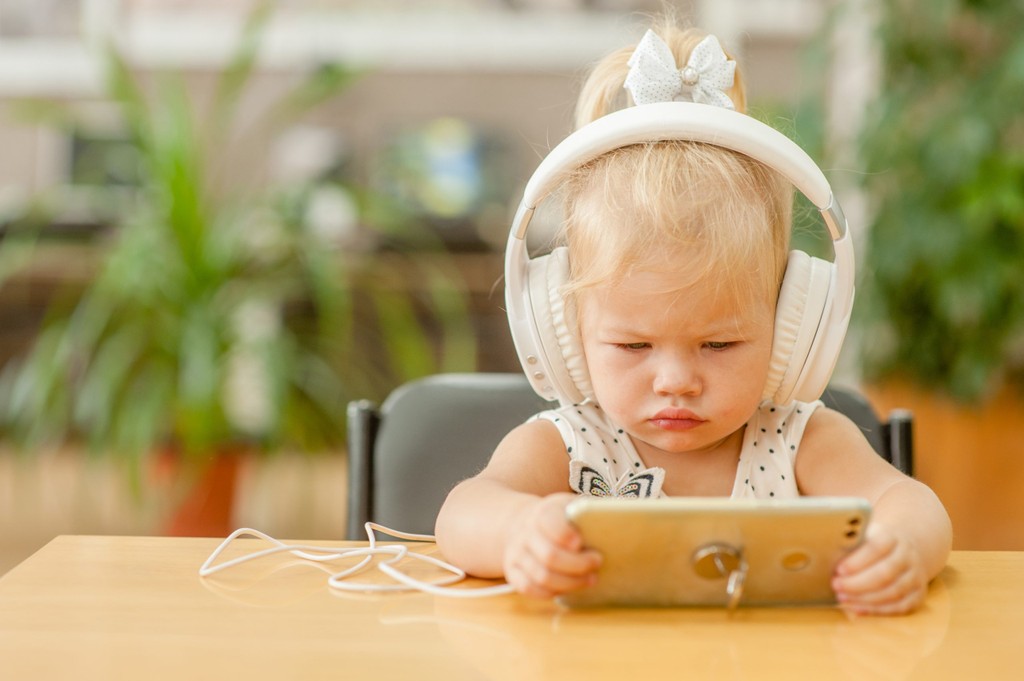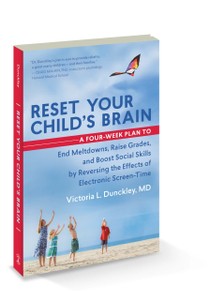Brain Child: Media and the Adolescent Mind
By Daniel Binus, MD
This article was originally published in the Fall 2019 issue of Shift Magazine.
The Impact of Media in Society
We see the impact of media everywhere in our society. Most of us interact with some sort of electronic devices throughout most of our waking hours. The Nielsen report from 2018 reports that adults in the United States now engage in media use for more than 11 hours per day. This is an increase from 10.5 hours in 2017. Teens use media an average of 9 hours per day, and this excludes time spent using media for school or homework!
The typical American spends more than 4 hours per day watching TV, which is equivalent to more than one 24-hour day in a week. By age 75, most of us will have spent more than 15.5 years in front of the TV.1 So how does this affect our brain, relationships, and overall mental health? Specifically, how does this impact the developing minds of our young people?
As a psychiatrist, these are questions that I have often pondered, especially as I have seen the rise of mental-health problems in the adolescent population. As a result, I have taken significant time to look at the impact of media on our mental health. The results have been concerning, to say the least, and have led me to suggest frequent interventions for media-related, mental-health issues.
The first thing I would like to emphasize is that media and electronic devices are not inherently bad. Every day I use a computer, my smart phone, the Internet, and different ways of communicating electronically to improve the quality of my life and the positive impact I can have on others. Media is powerful and can have a tremendous influence for good. However, like any other powerful tool, you can also easily cause harm if you use media devices inappropriately.

In this article I will focus on three main areas:
- The impact of media on our mental health
- The link between media and violence
- The effect of media on relationships.
I will then end with a few practical strategies to manage media use in the home.
Impact on Brain/Mental Health
When we first engage in a media-related activity such as watching television, gaming, using our smartphones, going online, or watching a movie, what Pavlov described as the orienting response is triggered. This simply means that media are made to grab our attention and keep our attention.2,3,4,5 This response activates the dopamine reward pathway in our brains and gives us a feeling of anticipation and reward. It also leads to increased activity in the limbic system, our emotional part of the brain, and under activity in the frontal lobe, our reasoning and self-control part of the brain.3,4,5,6,7,8,9
When one watches television, for example, brain waves in the frontal lobe switch predominantly to alpha waves within about 30 seconds of turning on the TV. This indicates a more passive, relaxed state in which the critical thinking and reasoning skills are largely dormant.7,8,9 Researchers state that television “effortlessly transmits huge amounts of information not thought about at the time of exposure.”7,9 Interestingly, while people watching TV feel more relaxed, their mood worsens afterwards, and they feel energy depleted, passive, and struggle to remain focused.10
Media and Mental Illness
Over the years, the evidence for a link between mental illness and television, gaming, and other forms of media has become increasingly strong.
For example, as early as the 1990s, the American Academy of Pediatrics has reported that early TV exposure is associated with the development of attention problems such as ADHD.11
Many people have been misled to believe that interactive screen time (such as gaming or using social media) is better than passive screen time (such as watching TV). This is simply not true. Interactive screen time is often worse for the user, especially in adolescence, as it causes dysregulation of the nervous system with hyper-arousal which can lead to emotional outbursts, meltdowns, irritability, and distractibility.12

Gaming, for example, can lead one to sacrifice real life relationships and forego other past-time activities. Furthermore, it can result in decreased sleep, problems at work, academic failure, lack of attention and verbal memory, aggression and hostility, dysfunctional coping, low wellbeing, and high levels of loneliness.13 Researchers see Internet overuse as being similar to self-medication with alcohol or other psychoactive drugs. Sleep deprivation, academic underachievement, failure to exercise and engage in face-to-face social activities, negative mood states, suicidal ideation, substance abuse, and decreased ability to concentrate are some of the known consequences of Internet overuse.14,15,16
Individuals identified as having social-media addiction were discovered to be at high risk of developing abnormal general mental health, somatic symptoms, anxiety, insomnia, social dysfunction, and severe depression.14,15 Smart phone use increases the likelihood of insomnia; in adolescence, it is also related to later bedtimes. This, in turn, contributes to academic problems and depressive symptoms.17,18
Moreover, sexually explicit material is now indiscriminately available to youth, and pornography viewing is shown to have significant negative mental and physical health effects.19 Television exposure and total media exposure in adolescence are associated with increased odds of depressive symptoms in young adulthood. Both TV viewing and mobile phone use contribute to the development of depressive symptoms.
In logistic regression models, each additional hour per day spent watching television or screen viewing was associated with greater odds (1.64 and 1.58 respectively) of prevalent depression in young adulthood, and dose- response relationships were indicated.20,21,22,23 This can become a self-perpetuating cycle.
Although heavy use of the Internet and video games is associated with an increased risk of depression, increased depression also predicts greater use of these media as well as withdrawal from sports participation and club activities.24 Using the Internet, even for social media purposes, or gaming throughout the day, can actually increase social anxiety. Online, you can create your own self-image, whereas in real social situations, you actually have to be yourself.25
Media and Violence
The impact of media and violence is controversial and has frequently been downplayed. A meta-analytic review reported that “the evidence strongly suggests that exposure to violent video games is a causal risk factor for increased aggressive behavior, aggressive cognition, aggressive affect, and for decreased empathy and prosocial behavior.”26
In a 2009 policy statement on media violence, the American Academy of Pediatrics said, “extensive research evidence indicates that media violence can contribute to aggressive behavior, desensitization to violence, nightmares, and fear of being harmed.”27
The Media Violence Commission of the International Society for Research on Aggression (ISRA) in its 2012 report on media violence said, “over the past 50 years, a large number of studies conducted around the world have shown that watching violent television, watching violent films, or playing violent video games increases the likelihood for aggressive behavior.” According to the commission, more than 15 meta-analyses have been published examining the links between media violence and aggression.28
This violent link is often minimized because of people’s concept of aggression. Often times, media use triggers forms of indirect aggression instead of actual physical violence. For example, the likelihood of a child becoming a bully between ages 6 and 11 has been linked to how much television this child watched at four years of age.
Often times excessive media use leads to confrontational body language and verbal aggression instead of physical violence. Internet and social media sites now make it easier for a student to bully a peer, and adolescents represent the majority of cyber bullying victims.28
Media and Relationships
Media is changing relationships. Recent research from UCLA shows that when teens learned that their own pictures supposedly received a lot of “likes,” they showed significantly greater activation in their brain’s reward circuitry—the same circuitry activated by seeing pictures of a person one loves.28 Adolescence is a particularly important time for social learning. During this time the brain becomes primed for certain rewards.
If we program our brains to be rewarded by media messages, we tend to start valuing real-life experiences much less.28
This programming can also impact our ability to read facial expressions and connect in healthy ways within relationships. Researchers surveyed college students between 1938 and 2007 and high school students between 1951 and 2002. They discovered an astounding 500 percent increase in mental-health problems during these time intervals.
The researchers concluded that the results best fit a model which incorporates “a cultural shift toward extrinsic goals, such as materialism and status and away from intrinsic goals, such as community, meaning in life, and affiliation.”30 It appears that the media is driving us apart and creating an emptiness in our hearts that no electronic device can fill.
Conclusion and Resources
So, what can we do to address this media-driven, mental-health crisis? First of all, adults—especially parents—need to provide better examples. While 72 percent of parents say their teens are sometimes or often distracted by their phone while having real-life conversations, 51 percent of teens say the same about their parents.31
We also need to start talking about screen time before it becomes a problem. This strategy also includes getting primary caregivers on the same page and having conversations between parents and children. Clear parameters need to be set and agreed upon regarding approved amounts of screen time and appropriate content.

Victoria Dunckley, MD

Parents also need to watch for telltale signs of media overuse/addiction such as increasing irritability, failing grades, decreased interest in activities, and appearing disconnected or distracted. Psychiatrist Victoria Dunckley has had tremendous results utilizing a “brain reset” program for individuals who have some of these evidences of media addiction. Amazing mental-health results are often seen within a couple weeks of restricting media intake.
Finally, children need to be offered positive alternatives to media use. These include such healthy activities as music opportunities, games, puzzles, reading, family meal times, time in nature, exercise, spiritual engagement, and community outreach activities.
As parents we want the very best for our children. Often times, when children start to hit adolescence, they all of a sudden seem to make a drastic change. I have heard parents say, “I don’t know what happened. My child just overnight became this defiant, confrontational person.” While behavior changes are common at this age, often times what parents are experiencing is just the inevitable consequences of the behavior and habits that have been formed over the past decade of their child’s life.
These changes may have taken place suddenly, but the root causes has likely been years in the making. In fact, the only thing that has changed, in many respects, is that the presenting behavior that used to be cute when the child was four or five is no longer cute. My advice to parents of children of all ages, but especially to the parents of younger children living in this age of constant technology overload, is to start early with a plan. Realize that how you raise your three-year-old will directly effect how your sixteen year-old will act.
My challenge to all parents is to consciously make the effort to spend more quality time with your children and control the use of technology in your home.

This disciplined approach from a young age will prove very valuable for your family unit down the road. Like many other areas in life, the more work you put into something in the beginning, the greater the reward down the road. And the reward of a happy, loving, and healthy family is priceless at any age.
References:
1. Nielson Report, 2014.
2. Kuss DJ. Internet gaming addiction: current perspectives. Psychol Res Behav Manag. 2013;6:125–37. doi:10.2147/PRBM.S39476.
3. Matsuda G, Hiraki K. Sustained decrease in oxygenated hemoglobin during video games in the dorsal prefrontal cortex: a NIRS study of children. Neuroimage. 2006;1;29(3):706–11.
4. Sigman, A. Remotely Controlled: How Television is Damaging Our Lives. Ebury Press, 2007.
5. Lang A, et al. The effects of edits on arousal, attention, and memory for television messages. J Broadcast Electron Media. 2000;44(1):94–109.
6. Goldberg I, et al. When the brain loses its self: prefrontal inactivation during sensorimotor processing. Neuron, 2006;50:329–39.
7. Krugman H. Brain wave measures of media involvement. Journal of Advertising Research. 1971;11(1):3–9.
8. Kubey R, Csikszentmihalyi M. Television addiction. Scientific American—Special Addition. 2004;14(1):48–55.
9. Koepp M, et al. Evidence for striatal dopamine release during a video game. Nature. 1998;393:266–68.
10. Sigman, A. Remotely Controlled: How Television is Damaging Our Lives. Ebury Press, 2007.
11. American Academy of Pediatrics, Committee on Public Education. Pediatrics. 1999;104:341–43.
12. Dunckley, V. Reset Your Child’s Brain. 1st ed. Canada: New World Liberty, 2015.
13. Kuss DJ. Internet gaming addiction: current perspectives. Psychol Res Behav Manag. 2013;6:125–37. doi:10.2147/PRBM.S39476.
14. Hanprathet N, et al. Facebook addiction and its relationship with mental health among Thai high school students. J Med Assoc Thai. 2015 Apr; 98(Suppl3):S81–90.
15. Li W, et al. Characteristics of internet addiction/pathological internet use in U.S. university students: a qualitative-method investigation. PLoS ONE. 2015 Feb 3;10(2). doi: 10.1371.
16. Ibid.
17. Lemola S, et al. Adolescents’ electronic media use at night, sleep disturbance, and depressive symptoms in the smartphone age. J Youth Adolescence. 2015;44:405–18. https://doi.org/10.1007/s10964-014-0176-x.
18. Hysing M, et al. Sleep and use of electronic devices in adolescence: results
from a large population-based study. BMJ Open 2015;5: e006748. doi:10.1136/ bmjopen-2014-006748.
19. Bailin A, et al. Health implications of new age technologies for adolescents: a review of the research. Curr Opin Pediatr. 2014 Oct;26(5):605–19.
20. Bulletin of Educational Psychology. 2008;39(3):355–76.
21. Primack BA, et al. Association between media use in adolescence and depression in young adulthood: a longitudinal study. Arch Gen Psychiatry. 2009;66(2):181–88. doi: 10.1001/archgenpsychiatry.2008.532.
22. Bickham DS, et al. Media use and depression: exposure, household rules, and symptoms among young adolescents in the USA. Int J Public Health. 2015;60(2): 147–55.
23. Grøntved A, et al. A prospective study of screen time in adolescence and depression symptoms in young adulthood. Prev Med. 2015 Dec;81:108–13. doi: 10.1016/j.ypmed.2015.08.009.
24. Romer D, et al. Older versus newer media and the well-being of United States youth: results from a national longitudinal panel. J. Adolesc. Health. 2013 May; 52(5):613–19. doi: 10.1016/j.jadohealth.2012.11.012.
25. Tonioni F, et al. Internet addiction: hours spent online, behaviors and psychological symptoms. Gen Hosp Psychiatry. 2012 Jan-Feb;34(1):80–87. doi: 10.1016/j.genhosppsych.2011.09.013.
26. Anderson CA, et al. Violent video game effects on aggression, empathy, and prosocial behavior in eastern and western countries: a meta-analytic review. Psychol Bull. 2010 Mar;136(2):151–73. doi: 10.1037/a0018251.
27. Kaplan, A. Violence in the media: what effects on behavior? Psychiatric Times. 2012;29(10). http://www.psychiatrictimes.com/child-adolescent- psychiatry/violence-media-what-effects-behavior
28. East S. Teens: This is how social media affects your brain. Updated August 1, 2016. https://www.cnn.com/2016/07/12/health/social-media-brain/index.html
29. Healy J. Early television exposure and subsequent attention problems in children. Pediatrics. 2004;113(4):917–18.
30. Twenge J. Increases in depressive symptoms, suicide-related outcomes, and suicide rates among U.S. adolescents after 2010 and links to increased new media screen time. Clin. Psychol. Sci. 2018;6:3–17. doi:10.1177/2167702617723376.
31. Anderson J. Even teens are worried they spend too much time on their phones. Published August 23, 2018. https://qz.com/1367506/Pew-research-teens-worried-theyspend-too-much- time-on-phones.
****
Maund, E., Stuart, B., Moore, M., Dowrick, C., Geraghty, A.W.A., Dawson, S., & Kendrick, T. (2019). Managing antidepressant discontinuation: A systematic review. Annals of Family Medicine 17(1). (Link)
Dr. Daniel Binus, MD serves as the clinical director of Beautiful Minds Medical. He is also the founder of Beautiful Minds Wellness. Dr. Binus believes in addressing the emotional, physical, and spiritual factors that influence a person’s well being. This article was originally published in the Fall 2019 issue of Shift Magazine. Reposted with permission.
Categories
- Addiction
- ADHD
- Adolesents
- Anxiety
- Bipolar
- Boundaries
- Childhood Trauma
- Classes
- Cognitive Behavioral Therapy
- Community Support
- Connection
- Depression
- Gaming
- Grief
- Gut Health
- Heavy Metals
- Hope
- Hydrotherapy
- In the News
- Lifestyle
- Love
- Media
- Men's Health
- Mental Health News
- Mindfulness
- Nature
- Neuroplasticity
- Neurotoxins
- Newsletter
- Nutrition
- Psychiatric Medications
- PTSD
- Recovery
- relationships
- Research
- Root Causes
- Schizophrenia
- Self-care
- Spiritual Growth
- Suicide
- Training
- Uncategorized
- Video
- Withdrawal from psychiatric medications
- Wokshops